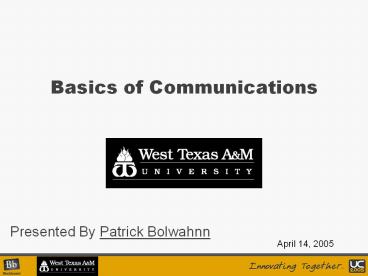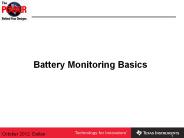Basics of Communications - PowerPoint PPT Presentation
Title: Basics of Communications
1
Basics of Communications
Presented By Patrick Bolwahnn
April 14, 2005
2
Today
- Session Objectives
- Learning and Understanding the Basics of Reader
Communication - Innovation
- Terminology
- Infrastructure Considerations
- Equipment and Devices
- Results
- The ability to understand and deploy a well
designed reader network.
3
WT Background
- Installed January 1998
- Wired February 1998
- Recarded Fall of 1998
- Services Offered
- Copy, Laundry, Vending, Bookstore
- Point of Sale, Activity Validation
- 120 Locations
4
WT Background
- FY 2003-2004
- 9000 Active Cardholders
- 1.5 Million in Deposits
- Meal Plans 300k
- Book Loans 350k
- Flexible Spending 850K
- 220 On-Campus Locations and 35 Off-Campus
Locations - Door Access
5
Terminology
- Network Processor - Transaction Approval
- Application Processor - Long Term Storage, DB
- Reader Networks Communications Devices,
Wiring and Readers - Locations - Location Number a Reader is Assigned
- Loop - Physical Wire
- Addresses - numbers 0-15 assigned to reader
6
Terminology
- Modems communication device (RS232)
- Converters Converts from one protocol to
another. - IP Communications Communicating over a Data
Network - RS232
- RS485
7
Terminology
- Do you have to be a wiring expert?
- NoJust need to know enough to make good
decisions
8
Installation Considerations
- AP/NP Location
- Number Size of Buildings
- Number Readers in each building
- Cable topology fiber, copper
- Network Strategy and Support
- Data Network
- Separate Reader Network / VLAN
- Power connections
- Shelf/rack space
9
WTAMU Communications
- Remote Line Driver loops
- IPC loops
- 1 IPC Loops
- 25 Active Loops
- 24 Remotes Loop
- 2 RF Loops
- 265 Locations
10
Reader Networks
- Consists of
- Network Processor
- Communications Devices
- Cabling
- Readers
- Cabling and Communication Devices make up the
three basic reader loops - Local
- Remote
- IP Network
11
Network Processor
- Network Processors communicates with each reader
on the network and processes their
transactions. - NPs Communicationis handled through
- CP16 Panels
- Mux Panel
- LAN Cards
12
Local Loops
- Local loops are generally within the same
building as the NP. Local loops can be
accomplished two ways. - Use CP8 boards which have some RS-485 converters
built in. - CP16 boards do not have converters
- NP cable to RS 485 converter
13
Remote loops
- A Remote Loop is any loop that services a remote
building(s) or remote campuses. This can be
accomplished through many combinations of
devices. - Devices Types
- Terminal Servers(TS) via a Data Network or
Internet - Line Drivers
- RS 485 converters.
- IP Converters
- IP Readers
14
Communications Protocols
- Protocols are like different languages. Some
protocols the BTSUE system uses to communicate
are - RS 485
- Allows multiple units to communicate over the
same wire. ( 5 pin) - RS 232
- Basic data communication used in PC and device
communication, 1 1 ( 3 pin) - TCP/IP
- Standard Networking protocol which Terminal
servers, IP Converters, IP readers utilize on
a data network.
15
Standard Communications
- Line Drivers
- Short haul modems less than 2 miles
- Long distance modems more than 2 miles
- Types of medium
- Fiber
- Copper
- Uses Standard RS 232 protocol (3 pin)
16
Standard Communications
- Special devices
- Multiplexer
- Loop Splitters
17
Standard Communications
- RS 485 Converters
- Design to convert RS 232 to 485 protocol
- Has 1x10 jack to connect local readercable
network
18
Standard Communications
Building A
Computer Center
NP
Line Driver
Line Driver
Reader
485
Line Driver
Loop Spliter
Line Driver
Building B
Line Driver
Building C
Line Driver
19
IP Communications
- Terminal Servers
- Designed to Convert RS232 to TCP/IP and back
again. - IP Converters
- Design to convert TCP/IP to RS 485 protocol
- IP enabled Readers VR/MDB2
20
IP Communications
First IP Communications devices were terminal
servers
NP
Terminal Server
Data Network
Terminal Server
RS 485
Reader
21
IP Communications
- IP Converters
- Design to convert TCP/IP to RS 485 protocol
22
IP Communications
NP
Data Network
IP Converter
IP Reader
RS 485
Reader
23
Other Communication Methods
- Radio Frequency
- Blackbox RF-115 modem
- 900 Mhz RS232 protocol
- Range up to 20 mileswith repeaters
24
Wiring
- Supported wiring
- Belden 8723
- 2 pair with shield
- Use T568b wall plate with screw lugsor DB 15
- Cat 5 10base-T (most common installation)
- Twisted Pair Network Cabling
- Use T568b RJ45 standard network jack
25
Pros for communication types
IP - easiest/quickest to install, or move -Easy
to diagnose communication problems??? -Comes back
on-line fairly quickly, when the network is out
-Could be used over the Internet to connect
remote campuses
Local Loops Lower cost no LD or TS. -Fast
response times. -Independent wiring not
attached to net.
Line Driver -Fast Response times. -Independent
wiring - not attached to data network. -Slightly
Cheaper than TS. -Supported by Blackboard -Simple
- No Configuration neededAlways up! -Works with
Copper and Fiber lines -Easy to troubleshoot
26
Cons for communication types
IP -Network Outage -Denial of Service -Firewall
and VLANs can block communication if not
configured right. -Depends highly on
relation-ship with IT
Local Loops -Difficult to move server.
Line Driver -Difficult to move server. -Copper
needs optical isolation - Cost of running wiring
if not available
27
Security Issues with IPC
- IPCs Communicate with the NP with 128bit
Blowfish encryption. - No problems so far with denial of service
attacks. - Downstream communication between IPC and Reader
is still vulnerable. - Having the IPC on a VLAN and behind a firewall
greatly increases security.
28
Recap
- Installation Considerations
- AP/NP Location
- Number Size of Buildings
- Number Readers in each building
- Cable topology fiber, copper
- Network Strategy and Support
- Data Network
- Separate Reader Network / VLAN
- Power connections
- Shelf/rack space
29
- Links
- Behind the Blackboard
- System Implementation Guidehttp//www.blackboard.
com/docs//h931431.pdf - Follow up Contact InformationPbolwahnn_at_mail.wtamu
.edu - If you remember one thingThere are many options
for deploying your reader network































